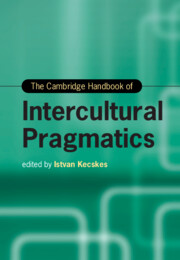Book contents
- The Cambridge Handbook of Intercultural Pragmatics
- Cambridge Handbooks in Language and Linguistics
- The Cambridge Handbook of Intercultural Pragmatics
- Copyright page
- Contents
- Figures
- Tables
- Acknowledgment
- Contributors
- Introduction The Rise of Intercultural Pragmatics
- Part I Theoretical Foundation
- Part II Key Issues in Intercultural Pragmatics Research
- Part III Interface of Intercultural Pragmatics and Related Disciplines
- Part IV Intercultural Pragmatics in Different Types of Communication
- 21 Visual and Multimodal Communication across Cultures
- 22 Intercultural Teamwork via Videoconferencing Technology: A Multimodal (Inter)action Analysis
- 23 Intercultural Communication in Computer-Mediated Discourse
- 24 Intercultural Aspects of Business Communication
- 25 Intercultural Pragmatics in Healthcare Communication
- 26 Academic and Professional Discourse in Intercultural Pragmatics
- 27 The Dynamic Model of Meaning Approach: Analyzing the Interculturality of Conspiracy Theory in Far-Right Populist Discourses
- Part V Language Learning
- Index
- References
25 - Intercultural Pragmatics in Healthcare Communication
from Part IV - Intercultural Pragmatics in Different Types of Communication
Published online by Cambridge University Press: 29 September 2022
- The Cambridge Handbook of Intercultural Pragmatics
- Cambridge Handbooks in Language and Linguistics
- The Cambridge Handbook of Intercultural Pragmatics
- Copyright page
- Contents
- Figures
- Tables
- Acknowledgment
- Contributors
- Introduction The Rise of Intercultural Pragmatics
- Part I Theoretical Foundation
- Part II Key Issues in Intercultural Pragmatics Research
- Part III Interface of Intercultural Pragmatics and Related Disciplines
- Part IV Intercultural Pragmatics in Different Types of Communication
- 21 Visual and Multimodal Communication across Cultures
- 22 Intercultural Teamwork via Videoconferencing Technology: A Multimodal (Inter)action Analysis
- 23 Intercultural Communication in Computer-Mediated Discourse
- 24 Intercultural Aspects of Business Communication
- 25 Intercultural Pragmatics in Healthcare Communication
- 26 Academic and Professional Discourse in Intercultural Pragmatics
- 27 The Dynamic Model of Meaning Approach: Analyzing the Interculturality of Conspiracy Theory in Far-Right Populist Discourses
- Part V Language Learning
- Index
- References
Summary
Medical communication is characterized by an essential cultural difference, as the nature of healthcare provider–patient interactions consists of an epistemic imbalance between the expert and the layperson. This specialized knowledge gap combines with other types of cultural differences, defined by mismatched background knowledge (including values, expectations, facts, or theories) and the proficiency in the use of distinct languages or dialects. Such cultural differences define a type of communication that is essentially and primarily intercultural.
Drawing on examples from different types of medical communication, we provide an overview of these studies in linguistics, pragmatics, and health communication to describe differences and commonalities between pragmatic strategies used in interactions of different types and levels of “interculturality.”
We propose a more consistent integration of pragmatics in healthcare communication by looking at how shared understanding is obtained in language-discordant contexts through the mediation of interpreters. Based on this analysis, we design a new communicative role for healthcare providers highlighting future perspectives for clinical training and practice. In this sense, the role played by an intercultural pragmatic approach in healthcare communication leads to redefining pragmatic strategies as part of a communicative toolbox, and not only as a discipline explaining how context affects meaning.
Keywords
- Type
- Chapter
- Information
- The Cambridge Handbook of Intercultural Pragmatics , pp. 652 - 682Publisher: Cambridge University PressPrint publication year: 2022
References
- 1
- Cited by



